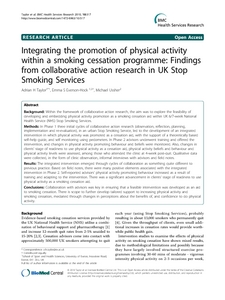Taylor, AH; Everson-Hock, ES; Ussher, M
(2010)
Integrating the promotion of physical activity within a smoking cessation programme: Findings from collaborative action research in UK Stop Smoking Services.
BMC HEALTH SERVICES RESEARCH, 10 (317).
pp. 1-11.
ISSN 1472-6963
https://doi.org/10.1186/1472-6963-10-317
SGUL Authors: Ussher, Michael Henry
![[img]](https://openaccess.sgul.ac.uk/1010/1.hassmallThumbnailVersion/1472-6963-10-317.pdf)  Preview |
|
["document_typename_application/pdf; charset=binary" not defined]
Published Version
Download (220kB)
| Preview
|
Abstract
Background: Within the framework of collaborative action research, the aim was to explore the feasibility of
developing and embedding physical activity promotion as a smoking cessation aid within UK 6/7-week National
Health Service (NHS) Stop Smoking Services.
Methods: In Phase 1 three initial cycles of collaborative action research (observation, reflection, planning,
implementation and re-evaluation), in an urban Stop Smoking Service, led to the development of an integrated
intervention in which physical activity was promoted as a cessation aid, with the support of a theoretically based
self-help guide, and self monitoring using pedometers. In Phase 2 advisors underwent training and offered the
intervention, and changes in physical activity promoting behaviour and beliefs were monitored. Also, changes in
clients’ stage of readiness to use physical activity as a cessation aid, physical activity beliefs and behaviour and
physical activity levels were assessed, among those who attended the clinic at 4-week post-quit. Qualitative data
were collected, in the form of clinic observation, informal interviews with advisors and field notes.
Results: The integrated intervention emerged through cycles of collaboration as something quite different to
previous practice. Based on field notes, there were many positive elements associated with the integrated
intervention in Phase 2. Self-reported advisors’ physical activity promoting behaviour increased as a result of
training and adapting to the intervention. There was a significant advancement in clients’ stage of readiness to use physical activity as a smoking cessation aid.
Conclusions: Collaboration with advisors was key in ensuring that a feasible intervention was developed as an aid to smoking cessation. There is scope to further develop tailored support to increasing physical activity and
smoking cessation, mediated through changes in perceptions about the benefits of, and confidence to do physical activity.
| Item Type: |
Article
|
| Additional Information: |
© 2010 Taylor et al; licensee BioMed Central Ltd. This is an Open Access article distributed under the terms of the Creative Commons Attribution License (http://creativecommons.org/licenses/by/2.0), which permits unrestricted use, distribution, and reproduction in any medium, provided the original work is properly cited |
| Keywords: |
Cooperative Behavior, Delivery of Health Care, Integrated, Female, Great Britain, Health Promotion, Health Services Research, Humans, Male, Motor Activity, Program Development, Program Evaluation, Smoking Cessation, State Medicine, Science & Technology, Life Sciences & Biomedicine, Health Care Sciences & Services, RANDOMIZED CONTROLLED-TRIAL, WITHDRAWAL SYMPTOMS, EXERCISE, BEHAVIOR, ABSTINENCE, WALKING, HEALTH, AID |
| SGUL Research Institute / Research Centre: |
Academic Structure > Population Health Research Institute (INPH) |
| Journal or Publication Title: |
BMC HEALTH SERVICES RESEARCH |
| ISSN: |
1472-6963 |
| Related URLs: |
|
| Dates: |
| Date | Event |
|---|
| 25 November 2010 | Published |
|
| Web of Science ID: |
WOS:000285254500001 |
  |
Download EPMC Full text (PDF)
|
 |
Download EPMC Full text (HTML)
|
| URI: |
https://openaccess.sgul.ac.uk/id/eprint/1010 |
| Publisher's version: |
https://doi.org/10.1186/1472-6963-10-317 |
Statistics
Item downloaded times since 07 Oct 2014.
Actions (login required)
 |
Edit Item |



